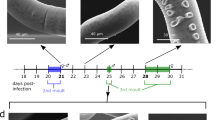Abstract
Scanning and electron microscopy was used to study the pathogenesis that occurred in mouse epithelial cells that had been penetrated byEimeria papillata sporozoites. Optimal penetration of parasites injected into nonligated and ligated mouse intestine was found to occur at 4–15 min post-inoculation. During initial penetration, the parasite caused disruption of the microvilli of the intestinal cells, which led to detachment of the microvilli from the plasma membrane of the penetrated cell. Host cells penetrated by the parasite showed extensive destruction of the internal cellular organization together with blebbing of host-cell cytoplasm and release of internal organelles such as mitochondria. Ultimately, the penetrated cells completely broke down, leaving vacuolated areas next to ultrastructurally normal epithelial cells.
Similar content being viewed by others
References
Augustine PC (1989) TheEimeria. In: Yvore P (ed) Cellular invasion and host-cell parasite interactions: Coccidia and intestinal coccidiomorphs. INRA, Paris, pp 205–215
Ball SJ, Pittilo RM (1990) Structure and ultrastructure. In: Long PL (ed) Coccidiosis of man and domestic animals. CRC Press, Boca Raton, Florida, pp 17–41
Chobotar B, Scholtyseck E (1982) Ultrastructure. In: Long PL (ed) The biology of the Coccidia. University Park Press, Baltimore, Maryland, pp 101–165
Danforth HD, Chobotar B, Entzeroth R (1984) Cellular pathology in mouse embryonic brain cells following in vitro penetration by sporozoites ofEimeria papillata. Z Parasitenkd 70:165–171
Doran DJ, Vetterling JM (1967) Cultivation of the turkey coccidiumEimeria meleagrimitis Tyzzer 1929 in mammalian kidney cultures. Proc Helminthol Soc Wash 34:59–65
Ernst JV, Chobotar B, Hammond DM (1971) The oocysts ofEimeria vermiformis sp. n. andE. papillata sp. n (Protozoa: Eimeriidae) from the mouseMus musculus. J Protozool 18:221–223
Gregory MW (1990) Pathology of coccidial infections. In: Long PL (ed) Coccidiosis of man and domestic animals. CRC Press, Boca Raton, Florida, pp 235–261
Hammond DM, Chobotar B, Ernst JV (1968) Cytological observations on sporozoites ofEimeria bovis andE. auburnesis, and anEimeria species from the Ord kangaroo rat. J Parasitol 54:550–558
Long PL, Speer CA (1977) Invasion of host cells by Coccidia: In: Tayler AER, Muller R (eds) Parasite invasion. Blackwell Scientific, London, pp 1–16
Miller LH, David PH, Hadley TJ, Hudsom DE (1983) Malaria merozoite invasion of erythrocytes. J Cell Biochem 7A [Suppl]:10
Pollari FL, Speer CA (1981) Scanning electron microscopy of merogonous stages ofEimeria falciformis varpragensis inMus musculus. Z Parasitenkd 66:99–108
Speer CA, Davis LR, Hammond DM (1971) Cinemicrographic observations of the development ofEimeria larimerensis in cultured bovine cells. J Protozool 18 [Suppl]:11
Author information
Authors and Affiliations
Rights and permissions
About this article
Cite this article
Danforth, H.D., Entzeroth, R. & Chobotar, B. Scanning and transmission electron microscopy of host cell pathology associated with penetration byEimeria papillata sporozoites. Parasitol Res 78, 570–573 (1992). https://doi.org/10.1007/BF00936454
Accepted:
Issue Date:
DOI: https://doi.org/10.1007/BF00936454




